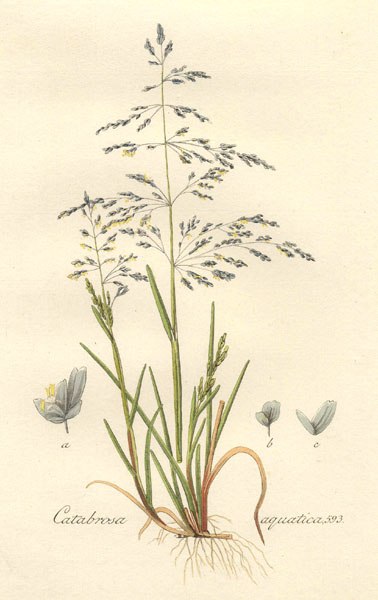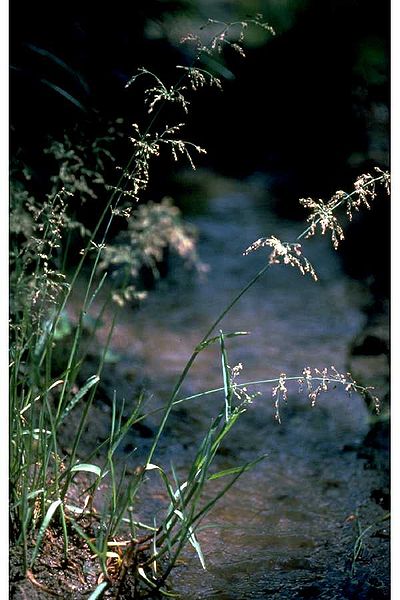 |
|
http://commons.wikimedia.org/wiki/File:Catabrosa_aquatica.jpg |
 |
| Gary Larson @ USDA-NRCS PLANTS Database / USDA NRCS. 1992. |
Translate this page:
Summary
Physical Characteristics

 Catabrosa aquatica is a PERENNIAL growing to 0.7 m (2ft 4in).
Catabrosa aquatica is a PERENNIAL growing to 0.7 m (2ft 4in).
See above for USDA hardiness. It is hardy to UK zone 3. It is in flower from June to August, and the seeds ripen from July to September. The species is hermaphrodite (has both male and female organs) and is pollinated by Wind.
Suitable for: light (sandy), medium (loamy) and heavy (clay) soils. Suitable pH: mildly acid, neutral and basic (mildly alkaline) soils. It can grow in semi-shade (light woodland) or no shade. It prefers wet soil and can grow in water.
UK Hardiness Map
US Hardiness Map
Synonyms
Glyceria aquatica.
Plant Habitats
Pond; Bog Garden;
Edible Uses
Seed[257]. No more information is given, but the seed is very small and fiddly to use. It would probably have been used as piñole or have been ground into a powder and used as a mush, as a thickener in soups and stews, or in making cakes, bread etc[K].
References More on Edible Uses
Medicinal Uses
Plants For A Future can not take any responsibility for any adverse effects from the use of plants. Always seek advice from a professional before using a plant medicinally.
A decoction of the plant has been used as a stimulant and tonic[257].
References More on Medicinal Uses
The Bookshop: Edible Plant Books
Our Latest books on Perennial Plants For Food Forests and Permaculture Gardens in paperback or digital formats.

Edible Tropical Plants
Food Forest Plants for Hotter Conditions: 250+ Plants For Tropical Food Forests & Permaculture Gardens.
More

Edible Temperate Plants
Plants for Your Food Forest: 500 Plants for Temperate Food Forests & Permaculture Gardens.
More

More Books
PFAF have eight books available in paperback and digital formats. Browse the shop for more information.
Shop Now
Other Uses
The plant has been burnt as an incense[257].
Special Uses
References More on Other Uses
Cultivation details
We have no information on this, though judging by the plants native habitat it requires a wet soil and also succeeds in shallow water. It will also probably require a fairly sunny position[K].
References Carbon Farming Information and Carbon Sequestration Information
Temperature Converter
Type a value in the Celsius field to convert the value to Fahrenheit:
Fahrenheit:
The PFAF Bookshop
Plants For A Future have a number of books available in paperback and digital form. Book titles include Edible Plants, Edible Perennials, Edible Trees,Edible Shrubs, Woodland Gardening, and Temperate Food Forest Plants. Our new book is Food Forest Plants For Hotter Conditions (Tropical and Sub-Tropical).
Shop Now
Plant Propagation
Seed - surface sow in the spring in a pot standing in shallow water. When they are large enough to handle, prick the seedlings out into individual pots and plant them out into their permanent positions in the summer. Division in the spring. The divisions can be planted direct into their permanent positions.
Other Names
If available other names are mentioned here
Native Range
TEMPERATE ASIA: Israel, Lebanon, Turkey, Armenia, Azerbaijan, Georgia NORTHERN AMERICA: Greenland, United States (Alaska) EUROPE: United Kingdom, Ireland, Iceland, Norway, Austria, Belgium, Switzerland, Czech Republic, Germany, Poland, Slovakia, Belarus, Estonia, Lithuania, Moldova, Russian Federation (Astrakhan, Kalmykija, Respublika, Karelia, Saratov, Volgogradskaja oblast), Ukraine (incl. Krym), Albania, Croatia, Italy, Romania, Serbia, Slovenia, Spain, France, Portugal AFRICA: Algeria, Libya, Morocco, Tunisia
Weed Potential
Right plant wrong place. We are currently updating this section.
Please note that a plant may be invasive in one area but may not in your area so it's worth checking.
Conservation Status
IUCN Red List of Threatened Plants Status :

Growth: S = slow M = medium F = fast. Soil: L = light (sandy) M = medium H = heavy (clay). pH: A = acid N = neutral B = basic (alkaline). Shade: F = full shade S = semi-shade N = no shade. Moisture: D = dry M = Moist We = wet Wa = water.
Now available:
Food Forest Plants for Mediterranean Conditions
350+ Perennial Plants For Mediterranean and Drier Food Forests and Permaculture Gardens.
[Paperback and eBook]
This is the third in Plants For A Future's series of plant guides for food forests tailored to
specific climate zones. Following volumes on temperate and tropical ecosystems, this book focuses
on species suited to Mediterranean conditions—regions with hot, dry summers and cool, wet winters,
often facing the added challenge of climate change.
Read More
Expert comment
Author
(L.)Beauv.
Botanical References
17
Links / References
For a list of references used on this page please go here
Readers comment
| Add a comment |
|
If you have important information about this plant that may help other users please add a comment or link below. Only comments or links that are felt to be directly relevant to a plant will be included. If you think a comment/link or information contained on this page is inaccurate or misleading we would welcome your feedback at [email protected]. If you have questions about a plant please use the Forum on this website as we do not have the resources to answer questions ourselves.
* Please note: the comments by website users are not necessarily those held by PFAF and may give misleading or inaccurate information.
To leave a comment please Register or login here All comments need to be approved so will not appear immediately.
|
Subject : Catabrosa aquatica
|
|
|
|